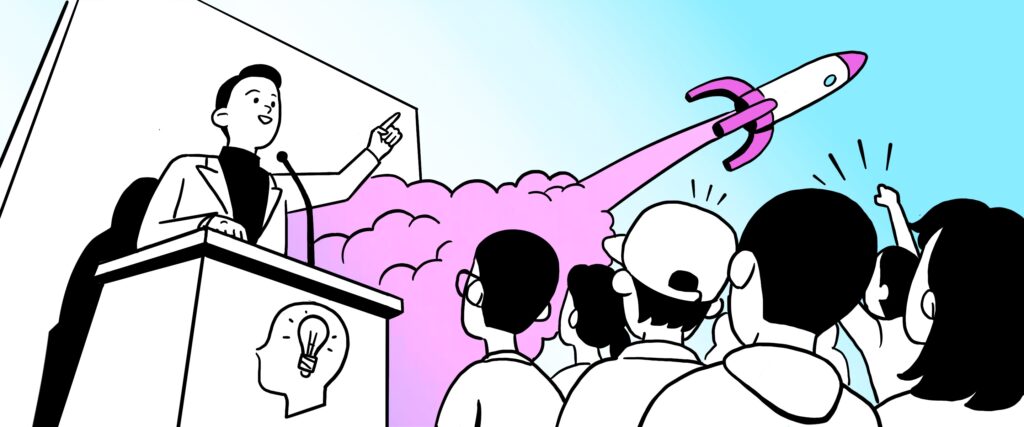POSTED IN
Marketing
WRITTEN BY
Nay Madani
DATE
In recent years, technological growth and the evolution of machine intelligence have transformed our society over the past decade. Creating an interconnected and symbiotic world has given rise to new societal and global challenges faced by bold and creative solutions.
A new leader is needed, but what kind of leader do we need to tackle these challenges?
This changing world gave rise to leaders who can develop and realize innovative ideas through the shared ambition of improving the world by employing and promoting an environment that promises creativity, innovation, and mission-driven entrepreneurship to its people. This type of leader is called creative leadership.
What is Creative Leadership?
The meaning can be of two things, a philosophy and an act.
As a philosophy, Creative Leadership embraces change as a way to seek opportunity everywhere. Envision desirable futures and unleash the courage, collaboration, and creativity of and from many contributors.
As an act, however, it builds on desirable futures through scalable enterprises derived from innovative strategies. Creativity, critical analysis, experimentation, a big vision of the future, collaboration, bold action, calculated risk-taking, and hard work drives to a specific participative value, which is to serve the triple bottom line in a business (planet, people, & profit).
So, what makes Creative Leadership different from Traditional Leadership?
It all boils down to the way they think and work. For instance;
The traditional way only focuses on improving, streamlining, standardizing, and cutting costs. It needs a hierarchical-authoritarian organization led by one leader that focuses on getting the whole team to work well together, pulling everyone towards the same goal, and ensuring that the decisions are implemented entirely. When they recruit people, they often see only their past merits, not their potential. Although accepting ideas from team members is encouraged, if it is too inaccurate or unrealistic, there will be concerns that the leader has based on their past endeavors (although not all leaders play safe).
Though in creative leadership, they lead through inspiration based on a clear vision of where they will go. Such leaders will constantly challenge existing rules, processes, and business models, trying to find innovative ways to address current and future challenges. Finally, they will dare their team members to bring out their creative ideas.
The 3 Creative Leadership Theories
Creative leadership is explained through these three leadership theories, which are as follows.
Transformational Leadership
It is an approach that causes a change in individuals. It creates a valuable and positive difference in the followers with the end goal of developing followers into leaders. Though in another form, it enhances team motivation, morale, and performance through various mechanisms.
These include connecting the sense of identity in followers and self to the mission and collective identity, challenging them to take greater ownership of their work, and understanding the strengths and weaknesses of followers for the leader to align followers with tasks that optimize their performance.
Authentic Leadership
The theory defines a leader as genuine, self-aware, and transparent. Authentic leaders could inspire loyalty and trust in their employees by consistently displaying who they are as a person and how they feel about the performance of their employees. They are self-aware, creating a solid sense of self from strengths to weaknesses. They will strive to do the right thing.
Displaying their real self at work, authentic leaders may create a sense of trust amongst their team. They are more critical, straightforward, and honest with the team to let them know where they stand. They also made significant decisions with their help by allowing them to express their opinion openly and critically to strengthen and understand all points of view for the final decision.
Servant Leadership
This theory defines that servant leaders are more inclined to create a synergistic relationship between employees and a leader. In other words, the leader promotes innovation, empowerment, and the well-being of their employees.
This kind of leader is more empathic and committed to the personal growth of others. The development and mentoring of teams are more important because these types encourage their employees to look to serve others as their priority over individual gains. They will aim to share power with others and promote the development and growth of others.
Do creative leaders currently face any challenges?
Of course, there are! The world is evolving and changing every day. There are three ongoing challenges that creative leaders are bound to face in 2022.
- Keeping up with accelerated growth
The COVID-19 pandemic has influenced every niche and significantly increased business competition across all industries. Businesses have to reevaluate strategies to find new revenue opportunities. Meanwhile, demand for entertainment is rising and more widespread than ever before. This may overwhelm your team. Thus, checking and supporting your team may help your team keep up with the demands.
- Inspiring team members
Constant demand and insufficient time create a lack of inspiration for the team. It affects efficiency and creativity in content creation. However, leaders can engage in various activities remotely or offline together with their teams that can inspire a spark of creativity that may start the ideas to flow.
- Managing stakeholder’s expectations
Sometimes great ideas and concepts the team makes may not align with the stakeholders, especially if they are more inclined to be data-driven. Even if everything—from numbers and data to research results—follows what they wanted, it still can fail. Therefore, leaders could handle this by maintaining frequent feedback loops between each side. This action will adjust client expectations and keep any feedback clashes to a minimum.
The world’s ongoing evolution supported by technological advancements creates a rising concern in various aspects that gave rise to a need for a new kind of leadership. A leader with the qualities of creativity and innovation is crucial for the 21st century and beyond. That incorporates moral values and inspirational influence, creating social impact, inter-enterprise collaboration, and safeguarding planet Earth and its resources.
Don’t forget to visit our Instagram @nicetomeetyou.studio and the Pricing Page to work with Nice To Meet You!


